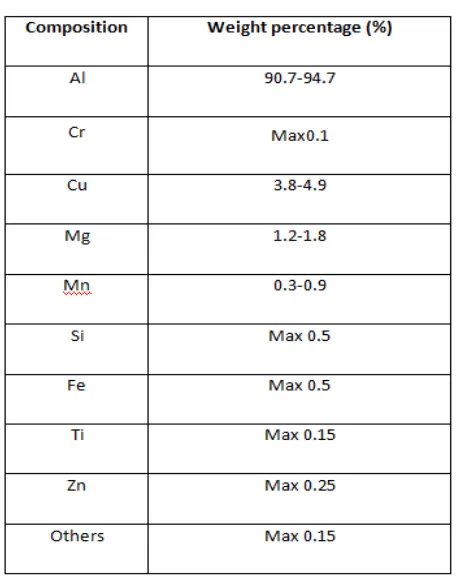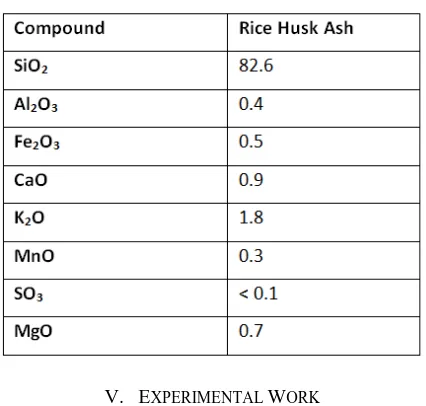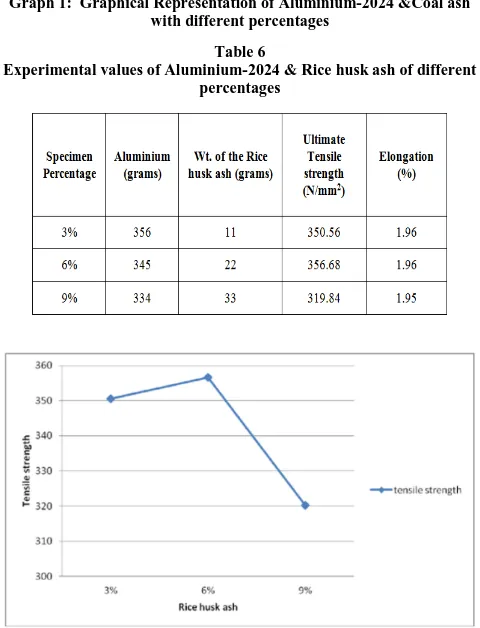International Journal of Emerging Technology and Advanced Engineering
Website: www.ijetae.com (ISSN 2250-2459, ISO 9001:2008 Certified Journal, Volume 7, Issue 6, June 2017)
176
Evaluation of the Ultimate Tensile Strength of Aluminium 2024
Reinforced With Fly Ash and Rice Husk Ash Metal Matrix
Composites
Upradista Chaitanya Vardhini
1, Avinash Gudimetla
2, Srimanthula Srikanth
3 1Pursuing M.Tech (CAD/CAM), Pragati Engineering College, Surampalem, India 2,3Asst. Professor, Dept. of ME, Pragati Engineering College, Surampalem, India
Abstract—Materials are frequently chosen for structural
applications because they have desirable combinations of mechanical characteristics. Development of metal matrix composites has become an important area of research interest in Materials Science. In view of this, the present study focuses on the formation of aluminium-fly ash and rice husk ash metal matrix composites. The present paper is aimed to study mechanical properties of Aluminium 2024 in the presence of fly ash, rice husk ash. Consequently aluminium metal matrix composite combines the strength of the reinforcement with the toughness of the matrix to achieve a combination of desirable properties not available in any single conventional material. The compositions were added up to the ultimate level and stir casting method is used for the fabrication of aluminium metal matrix composites. The mechanical behaviors of metal matrix composites like density, tensile strength, yield strength, elongation were ascertained by performing carefully designed laboratory experiments that replicate as nearly as possible the service conditions. The study can be further extended by evaluating the wear and corrosion of the resultant material.
Keywords—Metal matrix composites, Stir casting, Fly ash, Rice husk ash, Aluminium-2024.
I. INTRODUCTION
Composite material can be characterized as a mix of at least two materials that outcomes in preferable properties over those of the individual segments utilized alone. Rather than metallic amalgams, every material holds its different compound, physical, and mechanical properties. The two constituents are fortification and a grid. The primary points of interest of composite materials are their high quality and solidness, consolidated with low thickness, when contrasted and mass materials, taking into consideration a weight diminishment in the completed part. The fortifying stage gives the quality and firmness. By and large, the fortification is harder, more grounded, and stiffer than the network.
Metal lattice composites, at present however producing a wide enthusiasm for research crew, are not as broadly being used as their plastic partners. High quality, crack strength and solidness are offered by metal lattices than those offered by their polymer partners.
They can withstand hoisted temperature in destructive condition than polymer composites. Most metals and amalgams could be utilized as grids and they require fortification materials which should be steady over a scope of temperature and non-responsive as well. However the controlling perspective for the decision depends basically on the grid material. Light metals frame the network for
temperature application and the fortifications
notwithstanding the previously mentioned reasons are described by high module. Most metals and compounds make great frameworks. Just light metals are responsive, with their low thickness demonstrating leverage. Titanium, Aluminum and magnesium are the well known framework metals right now in vogue, which are especially helpful for airplane applications. On the off chance that metallic grid materials bring to the table high quality, they require high modulus fortifications. The quality to weight proportions of coming about composites can be higher than generally amalgams.
The softening point, physical and mechanical properties of the composite at different temperatures decide the administration temperature of composites. Most metals, earthenware production and mixes can be utilized with lattices of low softening point compounds. The selection of fortifications turns out to be more hindered with increment in the dissolving temperature of framework materials.
Composites are most encouraging materials of late intrigue. Metal framework composites (MMCs) have
fundamentally enhanced properties contrasted with
International Journal of Emerging Technology and Advanced Engineering
Website: www.ijetae.com (ISSN 2250-2459, ISO 9001:2008 Certified Journal, Volume 7, Issue 6, June 2017)
177
The use of waste material in Metal Matrix Composites has been getting more consideration as they can strengthen particles in metal network which improve the quality properties of the composites. Likewise, by applying these squanders materials in helpful way spare the assembling expense of items as well as lessen the contaminations on environment. As of late, a few research endeavors have been coordinated at creating aluminum combination MMCs. Investigate must be escalated to create modest aluminum MMCs with comparable or potentially better designing application., the restricted learning of fly fiery debris rice husk slag fortified aluminum MMCs. Thinks about on A356, A360 and 443 fly cinder strengthened aluminum MMCs have indicated incredible guarantee particularly in car applications. There is, along these lines, a sensible ground to complete more research on other aluminum composites keeping in mind the end goal to enhance our comprehension of fly fiery debris rice husk cinder fortified aluminum MMCs.II. LITERATURE SURVEY
[1] The physical and mechanical properties that can be obtained with metal matrix composites (MMCs) have made them attractive candidate materials for aerospace, automotive and numerous other applications. More recently, particulate reinforced MMCs have attracted considerable attention as a result of their relatively low costs and characteristic isotropic properties. Reinforcement materials include carbides, nitrides and oxides. In an effort to optimize the structure and properties of particulate reinforced MMCs various processing techniques have evolved over the last 20 years. The processing methods utilized to manufacture particulate reinforced MMCs can be grouped depending on the temperature of the metallic matrix during processing. Accordingly, the processes can be classified into three categories: (a) liquid phase processes, (b) solid state processes, and (c) two phase (solid-liquid) processes. Regarding physical properties, strengthening in metal matrix composites has been related to dislocations of a very high density in the matrix
originating from differential thermal contraction,
geometrical constraints and plastic deformation during processing.
[2] Materials are frequently chosen for structural applications because they have desirable combinations of mechanical characteristics. Development of hybrid metal matrix composites has become an important area of research interest in Materials Science. In view of this, the present study focuses on the formation of aluminium-Sic-fly ash hybrid metal matrix composites.
The present study was aimed at evaluating the physical properties of Aluminium 2024 in the presence of silicon carbide, fly ash and its combinations. Consequently aluminium metal matrix composite combines the strength of the reinforcement with the toughness of the matrix to achieve a combination of desirable properties not available in any single conventional material. The compositions were added up to the ultimate level and stir casting method was used for the fabrication of aluminium metal matrix composites. Structural characterization was carried out on metal matrix composites by x-ray diffraction studies and optical microscopy was used for the micro structural studies. The mechanical behaviours of metal matrix composites like density, tensile strength, yield strength, elongation and hardness tests were ascertained by performing carefully designed laboratory experiments that replicate as nearly as possible the service conditions. In the presence of silicon carbide and fly ash [SiC (5%) + fly ash (10%) and fly ash (10%) + SiC (10%)] with aluminium, it was fairly observed that the density of the composites was
decreased and the hardness was increased.
Correspondingly, the increase in tensile strength was also observed but elongation of the hybrid metal matrix composites in comparison with unreinforced aluminium was decreased. The aluminium-SiC-fly ash hybrid metal matrix composites significantly differed in all of the properties measured. Aluminium in the presence of SiC (10%)-fly ash (10%) was the hardest instead of aluminium-SiC and Aluminium-fly ash composites. The study can be further extended by evaluating the wear and corrosion of the resultant material.
III. OBJECTIVE
The fundamental goal of this paper is to build extreme rigidity. In this paper Aluminium 2024 & fly ash, Aluminium-2024 & rice husk cinder composites are delivered and extreme elasticity is thought about in both cases.
IV. MATERIALS AND METHODS
A. Materials
International Journal of Emerging Technology and Advanced Engineering
Website: www.ijetae.com (ISSN 2250-2459, ISO 9001:2008 Certified Journal, Volume 7, Issue 6, June 2017)
178
Table1
chemical composition of aluminium alloy2024
B. Reinforcement Choice:
1. Fly Ash:
Fly fiery debris is one of the buildups created in the burning of coal. It is a mechanical by-item recuperated from the vent gas of coal consuming electric power plants.
Contingent on the source and cosmetics of the coal being scorched, the segments of the fly cinder created fluctuate impressively, however all fly fiery debris incorporates generous measures of silica (silicon dioxide, SiO2) (both
shapeless and crystalline) and lime (calcium oxide, CaO). When all is said in done, fly fiery remains comprises of SiO2, Al2O3, Fe2O3 as significant constituents and oxides
[image:3.612.55.283.153.443.2]of Mg, Ca, Na, K and so on as minor constituent. Fly powder particles are for the most part round fit as a fiddle and range from under 1 µm to 100 µm with a particular surface zone, normally in the vicinity of 250 and 600 m2/kg. The particular gravity of fly cinder fluctuate in the scope of 0.6-2.8 gm/cc.
Table 2
Chemical Composition Fly Ash
2. Rice Husk ASH
The auxiliary security and quality normal for solid makes it the most broadly utilized material in the development business. Every one of the constituents of cement is gotten from earth's hull along these lines exhausting the world's common stores. On the opposite side human exercises are creating strong waste as mechanical waste and rural waste which add up to roughly 2500 MT for every year. In any case, from late research it has been reasoned that these natural and in-natural waste can create numerous by-items which can be utilized as a part of different structures. The regularly accessible waste is fly fiery debris, rice husk powder, silica seethe, ground granulated impact heater slag and annihilated building materials.
The utilization of mineral admixture in bond and cement has expanded significantly because of the current advances in the development innovation. This expansion sought after has been satisfied by the halfway substitution of bond by supplementary cementations materials. A lot of cost and vitality can be spared by utilizing mechanical by-items as SCM for supplanting bond.
International Journal of Emerging Technology and Advanced Engineering
Website: www.ijetae.com (ISSN 2250-2459, ISO 9001:2008 Certified Journal, Volume 7, Issue 6, June 2017)
[image:4.612.324.566.129.253.2]179
Rice husk is one of the by-results of shelling the rice. Husk is the external cover encompassing the paddy grain. Amid shelling of paddy 78-80% of the aggregate weight is removed as rice, broken rice and wheat while the rest 20-22 % is the husk. The 75% of aggregate husk got is a natural unpredictable material while the rest 25% gets changed over into slag amid the terminating procedure and is known as rice husk ash (RHA). The terminating procedure proceeds for around 48 hours. Because of developing interest for superior solid, high quality, low porousness concrete and exceptional cement for the development of seaward structures, spans, atomic power plant and marine structures and so forth, the interest for fine nebulous silica has likewise expanded. In this manner, RHA is a decent super-pozzolana and fills the need. In the event that the solid structures are not cured appropriately, voids are shaped in it. RHA being better than bond with molecule size of 25 microns fill the interstices amongst concrete and totals in this manner making the solid more thick and solid.Table 3
Chemical Composition Rice Husk Ash
V. EXPERIMENTAL WORK
The mix throwing strategy additionally called fluid state technique is utilized for the generation of metal lattice composites .In this strategy scattered stage is blended with liquid metal by methods for manual mixing .The fluid composite material is then thrown by ordinary throwing strategies.
Figure 1: Manual Stir Casting
[image:4.612.62.275.379.582.2]The aluminium-coal fiery remains and aluminium-rice husk powder metal lattice composites are set up by mix throwing strategy. For this we have chosen monetarily unadulterated aluminum-2024 liquefied in the heater up to 6000C. Fortified material, for example, rice husk fiery remains and coal cinder are pre-warmed to expel dampness. At first took 500grams of unadulterated aluminum-2024 liquefied upto softening point at that point by taking required measure of liquid metal for plate included distinctive extents of rice husk fiery remains i.e.,11grams, 22grams, 33grams.In a similar way we took coal powder pre-warmed blended with aluminium - 2024 liquid metal to shape plates.
[image:4.612.324.564.420.601.2]International Journal of Emerging Technology and Advanced Engineering
Website: www.ijetae.com (ISSN 2250-2459, ISO 9001:2008 Certified Journal, Volume 7, Issue 6, June 2017)
[image:5.612.47.292.146.275.2]180
1. Machining o f Metal Matrix Composites:Figure 3: Composite Plate
VI. MECHANICAL PROPERTIES OBSERVATIONS
[image:5.612.324.564.273.587.2]1. Tensile Behaviour:
Table 4
Experimental values of Aluminium-2024
[image:5.612.59.276.336.468.2]The pliable testing is finished utilizing a modernized all inclusive tractable testing machine according to ASTM-B557 benchmarks. Standard example with guage length is utilized to assess extreme elasticity, yield quality, rate prolongation. The example tests of various weight extents are tried under general testing machine to assess elasticity. The accompanying are the outcomes gotten by testing tests.
Table 5
Experimental values of Aluminium-2024 & Coal ash of different percentages
Graph 1: Graphical Representation of Aluminium-2024 &Coal ash with different percentages
Table 6
Experimental values of Aluminium-2024 & Rice husk ash of different percentages
[image:5.612.57.279.561.697.2]International Journal of Emerging Technology and Advanced Engineering
Website: www.ijetae.com (ISSN 2250-2459, ISO 9001:2008 Certified Journal, Volume 7, Issue 6, June 2017)
181
VII. RESULTS
A. Comparision of Al-2024, Coal ash with Al-2024 & Rice husk ash:
Graph 03: Comparision of Al-2024 Coal ash with Al-2024& Rice husk ash
B. Comparision of Ultimate Tensile Strength and % Reinforcement:
Graph 04: Comparision of Ultimate Tensile Strength and % Reinforcement
VIII. CONCLUSION
Aluminium2024-coal ash, Aluminium2024-rice husk ash (various concentrations) metal matrix composites are successfully fabricated by stir casting process.
Based on the experimental observations the following conclusions have been drawn:
At 3% of both specimens Aluminium2024-coal ash and Aluminium2024-rice husk ash, Al2024-ricehusk ash yields better tensile strength.
At 6% of both specimens Aluminium2024-coal ash and Aluminium2024-rice husk ash, Al2024-ricehusk ash yields better tensile strength.
At 9% of both specimens Aluminium2024-coal ash and Aluminium2024-rice husk ash, Al2024-coal ash yields better tensile strength.
By comparison of Aluminium2024-coal ash,
Aluminium2024-Rice husk ash with different
compositions (3%,6%,9%),among them
Aluminium-Rice husk ash at 6% yield high tensile strength.
When comparision of highest value of tensile strength i.e., at 3%of Aluminium-coal ash and at 6% Aluminium- rice husk ash.
REFERENCES
[1] Ibrahim, I.A., Mohamed, F.A. & Lavernia, E.J. J Mater Sci (1991) 26: 1137. doi:10.1007/BF00544448
[2] M. Mahendra Boopathi, K. P. Arulshri and N. Iyandurai
[3] Sudarshan and M.K. Surappa, 2008. Synthesis of fly ash particle reinforced A356 Al composites and their characterization. Mater. Sci. Eng. A, 480: 117-124. DOI: 10.1016/j.msea.2007.06.068 [4] Surappa, M.K., 2003. Aluminium matrix composites: Challenges
and opportunities. Sadhana, 28: 319-334. DOI:
10.1007/BF02717141
[5] Sannino, A.P. and H.J. Rack, 1995. Dry sliding wear of discontinuously reinforced aluminum composites: Review and discussion. Wear, 189: 1-19. DOI: 10.1016/0043-1648(95)06657-8 [6] Sarkar, S. and A. Singh, 2012. Studies on aluminum-iron ore in-situ


